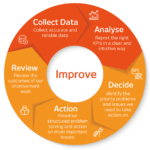OKR vs KPI. What is the difference?

It's not unusual to hear people say things like 'We don't need KPIs, we have OKRs'. This shows a misunderstanding of what OKRs and KPIs are. It isn't a case of OKR vs KPI, they are complementary concepts that work together. To clear this up, let's look at what each term really means....
What is a KPI?
A Key Performance Indicator (KPI) is a measure of how we are doing at something that we care about.
You use them every day in your personal life, probably without ever thinking of them as KPIs.
The answers to questions like ‘How much do I weigh?’, ‘How much money do I have in my bank account?’, and ‘How many units of alcohol have I drunk this week?’ are provided by KPIs (‘weight’, ‘bank balance’, and ‘units of alcohol consumed’).
Limitations of KPIs
KPIs do not tell you whether something is good or bad, they are simply a quantified value of that thing.
A KPI is intended to provide an objective numerical value related to a specific activity or outcome. KPIs provide an important foundation for our discussion.

What is an OKR?
If you haven’t come across them already OKR is a goal-setting approach pioneered in Intel, based on Peter Drucker’s work on Management by Objectives in the 1950s, which is now used widely across the corporate world. OKR stands for ‘Objective Key Results’.
The Objective element describes a substantial, often long term outcome we want to achieve.
The Key Result is a smaller outcome, a stepping stone goal, that will help us reach that big ‘Objective’.
An example personal OKR...
- Objective: Give up smoking
- Key Result: Go 10 days without a cigarette
An example corporate OKR...
- Objective: Quadruple online sales
- Key Result: Grow email list to 50k subscribers 24 Introduction GAMED Strengths of the OKR approach
The OKR approach is powerful, flexible, and gloriously simple to explain.
So, both the Objective and Key Results are targets.
We need to know how we are progressing on our Objectives and Key Results, so each Key Result is accompanied by a KPI to indicate progress.
Limitations of the OKR approach
The OKR approach does not offer:
- Guidance on whether those targets will deliver the intended higher-level strategic outcome.
- Indication of likely ‘gaming’ by the OKR owners.
- Identification of unintended consequences.
Like SMART objectives, the stock OKR approach only covers target setting and offers no guidance on incentive design.
Why the OKR vs KPI question makes no sense...
OKRs are a specific form of target (Objective is a high-level target, Key Results are targets for the critical drivers for the identified Objective).
To gauge the success of our OKRs, we must use KPIs or metrics to track our performance versus those targets. So OKRs and KPIs are not alternatives, but are complementary concepts.







